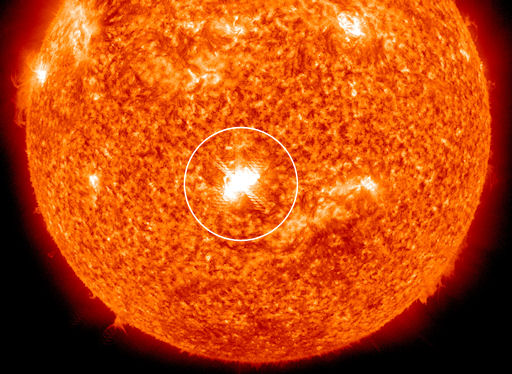
SpaceWeather.com says we’re overdue for a plasma bullet from the Sun. In Saturday issue (at that last link) they have a movie of a plasma blast coming out of sunspot 1147, on the eastern (left) edge of our nearest star.
Yesterday they reported this:
SOLAR FLARE: Sunspot 1158 has just unleashed the strongest solar flare of the year, an M6.6-category blast @ 1738 UT on Feb. 13th. The eruption appears to have launched a coronal mass ejection (CME) toward Earth. It also produced a loud blast of radio emissions heard in shortwave receivers around the dayside of our planet. Stay tuned for updates!
BEHEMOTH SUNSPOT 1158: Sunspot 1158 is growing rapidly (48 hour movie) and crackling with M-class solar flares. The active region is now more than 100,000 km wide with at least a dozen Earth-sized dark cores scattered beneath its unstable magnetic canopy. Earth-directed eruptions are likely in the hours ahead.
And today they say,
EARTH-DIRECTED SOLAR FLARE: On Feb. 13th at 1738 UT, sunspot 1158 unleashed the strongest solar flare of the year so far, an M6.6-category blast. NASA’s Solar Dynamics Observatory recorded an intense flash of extreme ultraviolet radiation, circled below:
The eruption produced a loud blast of radio waves heard in shortwave receivers around the dayside of our planet. In New Mexico, amateur radio astronomer Thomas Ashcraft recorded these sounds at 19 to 21 MHz. “This was some of the strongest radio bursting of the new solar cycle,” he says. “What a great solar day.”
Preliminary coronagraph data from STEREO-B and SOHO agree that the explosion produced a fast but not particularly bright coronal mass ejection (CME). The cloud will likely hit Earth’s magnetic field on or about Feb. 15th. High-latitude sky watchers should be alert for auroras.
The shot above is one I took on a flight from San Francisco to London in 2007. For some reason it flew far south of the usual route, giving me a somewhat distant view of the aurora that showed up outside my window on the left side of the plane. It was my first good view of one.
I shot another set here on a later flight a few weeks later. When flying to and from Europe, always get a seat on the north side if you want to see the show.
Meanwhile, watch SpaceWeather for more developments. Also NOAA’s Space Weather Service, which yesterday said this:
February 11, 2011 — Region 11153 has rotated on to the far side of the Sun, having given us an M class flare and a handful of small C class flares over the past few days. Recently, there have been some small active regions appearing and disappearing that haven’t bothered to produce any interesting activity and there are currently 4 of them on the disk. What has the attention of forecasters is the Sun’s East limb, where old Region 11149 is just beginning to reappear having transited the far side of the Sun. During that transit, multiple coronal mass ejections were observed that were directed away from the Earth. If that region stays active, we could be in store for some interesting space weather in the days ahead as it moves towards the center of the solar disk.
I have a feeling we’ll be taking a plasma bullet in the next few days.

Leave a Reply